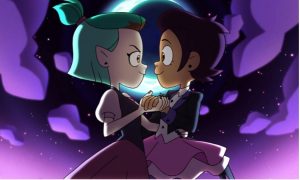For many LGBTQ+ people, representation can help them to come to terms with their gender/sexuality and so it is important that positive representation exists in media. However historically, LGBTQ+ representation in film and TV has been lacking, with many characters conforming to stereotypes or enduring cruel fates.
With the introduction of the ‘Hays Code’ in the USA in 1934, LGBTQ+ characters were prohibited from appearing in film. Though homosexuality was never specifically mentioned, the law stated that movies must not “lower the moral standards of those who see [them]” – and at the time being LGBTQ+ was considered immoral. These were lifted in 1968, but this still left three decades with the only representation being queer-coded villains.

Following the lifting of the ‘Hays Code’ and the Stonewall Riots of 1969, came the cult classic The Rocky Horror Picture Show in 1975. The musical featured an array of LGBTQ+ characters and introduced some much-needed positive representation. The 1980s unfortunately worsened the stigma around LGBTQ+ people due to the AIDs crisis. Nevertheless, in 1985 Desert Hearts was released, which is regarded as the first mainstream lesbian film with a happy ending.
In 1988, Margaret Thatcher introduced ‘Section 28’ in the UK – a law that prohibited “promoting the teaching of the acceptability of homosexuality” within schools – which wasn’t abolished until 2003. This meant for many people in the 90’s, TV was the only place they could go to learn more about the LGBTQ+ community. 1989 brought the first gay kiss on UK television in an episode of Eastenders, which was unfortunately followed by a slew of homophobic backlash. In 1997, Ellen became the first American show to feature a gay lead character, after star Ellen DeGeneres came out as a lesbian. In the UK, Queer as Folk aired in 1999 on Channel 4, which followed a group of out gay men in Manchester – and depicted the LGBTQ+ community as vibrant and alive. Other shows such as Will & Grace and Buffy the Vampire Slayer began featuring recurring LGBTQ+ characters.

In recent years, there have been numerous great examples of representation within cinema. In 2017, Moonlight was the first LGBTQ+ movie (and first with an all-black cast) to win an Oscar for Best Picture. Love, Simon (2018) is regarded as the first movie by a major Hollywood studio to feature a gay lead character. In the world of Superheroes, Marvel introduced theirfirst gay superhero in 2021 in Eternals – whom director Chloé Zhao refused to censor from the film for foreign markets.
When it comes to television, Netflix’s Sense8 (2015-2018) featured several healthy LGBTQ+ relationships. In 2017, Bojack Horseman character Todd Chavez came out as asexual – and was the only asexual character in streaming in 2018 [GLADD]. Supergirl on the CW introduced us to DC’s first trans superhero with Dreamer, who featured as a major character for the final 3 seasons. In 2020, It’s A Sin shone a light on what it was like to live through the AIDs crisis in the UK.
 Even children’s television is starting to gain more representation. DreamWorks’ She-Ra and the Princesses of Power featured a lesbian romance between lead characters, as well as a parental gay couple. Disney’s The Owl House features lesbian, asexual, bisexual, and non-binary lead and recurring characters. On Cartoon Network, Steven Universe features various LGBTQ+ characters and often combats gender stereotypes. This kind of representation being shown to children is so important, both for young LGBTQ+ people to be able to see that being LGBTQ+ is okay, and for non-LGBTQ+ children, as it normalises it and makes it easier for them to become good allies.
Even children’s television is starting to gain more representation. DreamWorks’ She-Ra and the Princesses of Power featured a lesbian romance between lead characters, as well as a parental gay couple. Disney’s The Owl House features lesbian, asexual, bisexual, and non-binary lead and recurring characters. On Cartoon Network, Steven Universe features various LGBTQ+ characters and often combats gender stereotypes. This kind of representation being shown to children is so important, both for young LGBTQ+ people to be able to see that being LGBTQ+ is okay, and for non-LGBTQ+ children, as it normalises it and makes it easier for them to become good allies.
Since 2005, GLAAD has published an annual report to show how representation is changing in TV. In the 2005-2006 season, 1.4% of regular characters on broadcast primetime shows were LGBTQ+, whilst in 2020-2021, the figure was up to 9.1% – and over half of these characters were people of colour. It is important to remember though that more can be done – the most recent study found that 20% of these LGBTQ+ characters appeared in a series created by just 1 of 4 TV producers.
All in all, it is amazing to see how far representation has improved – particularly over the past 20 years – and hopefully, this trend will continue until there is consistent representation of everyone throughout the film and TV industries.
To end, I thought I’d provide a list of some other shows with great LGBTQ+ relationships and/or characters:
- Schitt’s Creek
- The Haunting of Bly Manor
- Brooklyn Nine-Nine
- Star Trek: Discovery
- Love, Victor
- Pose
Written by Joshua Littleford, Student Champion


Great article! I recommend Black Sails too – a historical TV series on the scale of Vikings, featuring queer pirates and somehow relatively unknown.
Geweldig artikel over LGBT (Great article about LGBT)
please please watch Heartstopper if you haven’t already its just so incredible and as a queer girl like damn i really relate to it always makes me cry